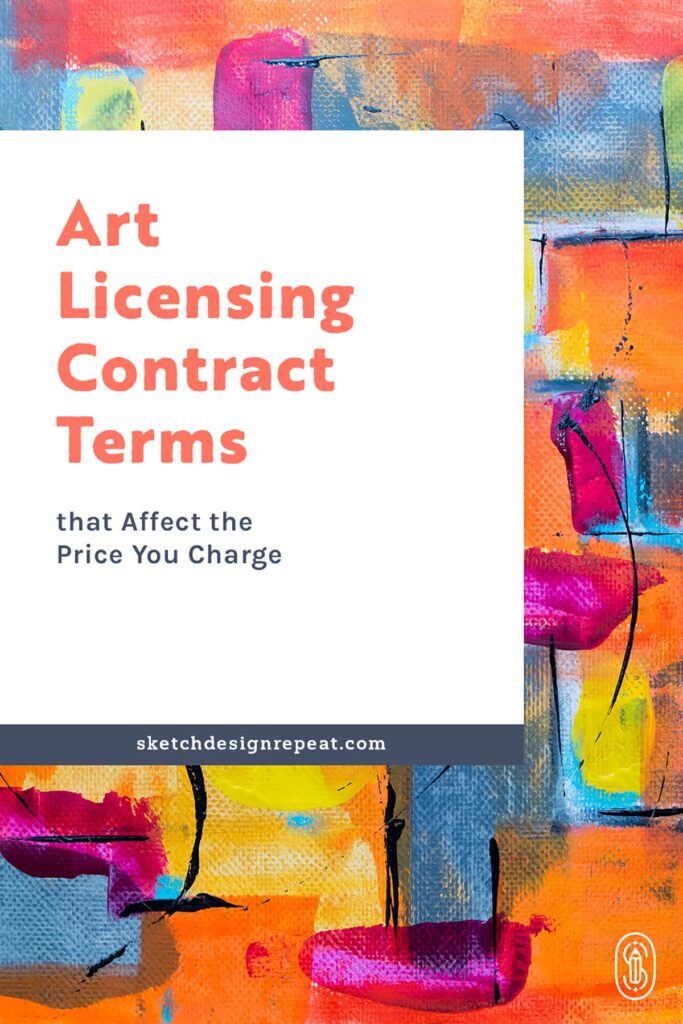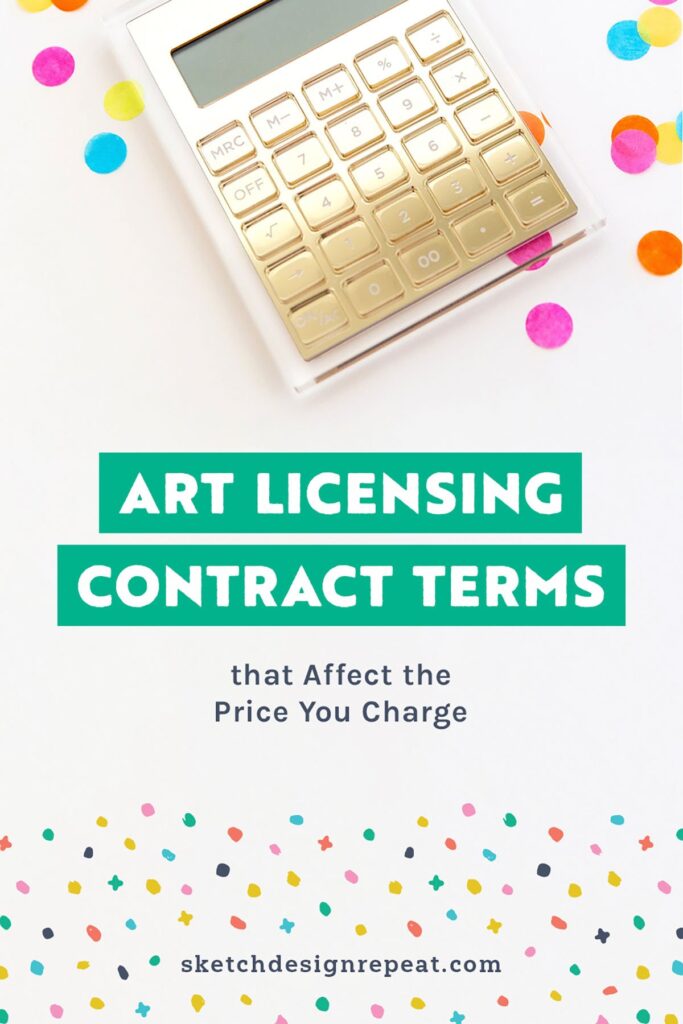Art licensing agreements all tend to be structured the same, but if you’re a new surface pattern designer or artist looking to license designs in your portfolio, you may not know what to look for.
Even more concerning is that you’ll often be asked about your prices (especially for flat-fee licenses) before you get to discuss the terms of the contract. And that’s problematic because without knowing what the terms of the art licensing contract are, it’s impossible to give an accurate price (and often that means you’ll end up undercharging).
So let’s talk about the 3 most important contract terms that always need to be discussed BEFORE you send a price quote to a company. But before we do…
DISCLAIMER: I am a surface designer, not a lawyer, and this post is to share what I’ve learned as a self-employed artist and should NOT be seen as legal advice. Please consult an attorney if you need legal assistance with your business.
1. Products
The MOST important term that affects price is the products the company will be putting your art onto and selling — this could be as small as one product like greeting cards or as big as an entire product category like home decor. And the rule is that the more products your art will be used for, the higher your price should be.
But I also strongly recommend that the products listed in the contract are as specific and narrow as possible because vagueness is never a good thing when it comes to art licensing contracts.
For example, let’s say a company wants to license 2 of your designs for home decor. Well that’s a HUGE category of products and could include anything from pillows to rugs to wall art, but maybe they’re a company that primarily sells pillows and blankets.
In that instance, it would be worth it to ask that the licensing contract to only be for pillows and blankets because that would allow you to license your designs to another home decor company that sells anything beyond those two products.
So remember, if the company is vague when discussing product categories for a licensing contract, ask them to list the exact products in the contract OR hike up your price so you’re well compensated.
2. Territory
Where a company’s products will be sold is the next thing to consider when deciding on how to price your artwork. If it’s a small, family-based business that sells locally they likely only need their own country as the territory but if it’s a big, multinational company they’re much more likely to ask for worldwide.
And yes, the price for worldwide rights should definitely be higher than a single country or region.
But what about companies that only ask for a single country territory in the contract but sell their products online — doesn’t that technically mean they sell worldwide?
This is a question I get from my Artful Pricing students frequently and yes, technically they may sell to customers outside their country.
But smaller companies who only ask for their home country as the territory will usually sell the vast majority of their products (even on their website) to their local customers — as was the case with a Brazilian fabric company I licensed several designs to at the beginning of my career. But it’s always a good idea to ask where they ship to as part of your contract negotiations.
3. Duration
How long a company will produce products with your art is the last important term to nail down before determining what to charge as your licensing fee. The standard time is usually 2–3 years, however, I’ve signed 1-year contracts and 5-year contracts.
And although I did accept a few long contracts at the beginning of my career, I don’t recommend signing anything longer than 3 years unless it’s a royalty contract and you have past experience working with the company and are confident that the compensation will be good.
So if you get asked for a 5-year contract, respond by asking if they’ll consider 3 years instead. And if they’re adamant about wanting the long contract, increase your price by at least 30% (as you’ll have to wait a long time before you can license it out on the same products again).
But What About Exclusivity?
There’s a lot of confusion as to what exclusivity entails in art licensing contracts — even among companies — so you may be wondering why I didn’t include it in my list of terms that affect pricing.
But if you focus on the 3 terms I laid out above and make sure the contract is very specific on the products, territory, and duration — having the word “exclusive” in the contract in those specific term clauses doesn’t change the nature of the licensing agreement. So as long as you don’t sign something with vague terms, asking for worldwide exclusive rights in perpetuity, you’ll be ok.
That’s why it’s so important to make sure all the details you agree to are included in the contract AND that you read every line of a contract before you sign it.
But I also know as artists, we’re not familiar with all the legal jargon so we can’t always tell a good contract from a bad one — it’s taken me 5 years of negotiating 50+ contracts myself to learn the ins and outs of art licensing agreements.
It’s why I created my Artful Pricing course to help you learn contract basics in a way that won’t make you fall asleep or want to rip your hair out. Inside I show you not only how to read contracts and negotiate better terms for yourself, but also how to fairly price your art for buyouts, licensing, and freelance projects.
If you’re interested, click here to learn more.
And remember, the next time you get a pricing inquiry from a company, take a beat, re-read their email, and make sure they’ve given you enough information to answer the following questions:
- What products will they be using your art on?
- Where will they be selling it?
- How long will they have the ability to use your art?
As long as you do that and make sure their answers are specific, you’ll be able to give the company a fair price quote for both you AND them.
Want to save this post to find it later? PIN IT!


Thank you for the article.
So helpful Shannon, I can’t wait for your pricing course to help navigate this licensing thing!
Quick question for extra sku’s how much should we be adding? & extra colourways? Say if I give a base price for design for one sku & then they decide to add two more product skus in & maybe even another colourway? This kind of thing is making my head hurt trying to work it all out…any guidance would be much appreciated
Fleur x
An extra colorway can enhance a portfolio sheet, but I don’t usually charge for that (unless it’s an extra colorway for a large collection of patterns).
As far as what products they want, if they add anything outside the products listed in your contract, you should get additional compensation and a new contract for them 🙂
Hello, thank you very much for this great blog post. Such informations are immeasurably helpful for surface designers. Kind regards Anke